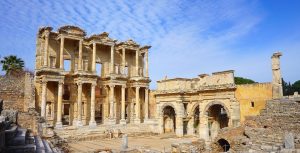Blog Titles
ToggleGladiators in Ephesus
The life of gladiators in Ephesus and gladiator fights in Ephesus
Located in Selcuk district of Izmir city in Turkey, Did you know that the ancient city of Ephesus was the first place where gladiators fought in Anatolia in BC. 71. How was the life of the Ephesian gladiators, who were they, what did they eat, what was their life like, how did the Ephesian gladiators gain their freedom or what would they do after they were free? The lives of the gladiators who lived in the city of Ephesus and the famous gladiators of the period.
Ephesus Gladiators
History of gladiator fights in Ephesus
The first gladiator games in Anatolia were organized in Ephesus in 71 BC. The rich people of Ephesus and the notables of the city of Ephesus had gladiators. These people would bet that their gladiators would win the fight, and they would organize games for it.
The rich and senators could sell their gladiators to each other.
Gladiator fights would last for at least 2 and at most 12 days, and the warriors who entered the arena in the gladiator games would fight to the death. Gladiators were chosen from among slaves or mercenaries, and they were specially trained. Gladiator schools were opened for the training of gladiators, learning fighting techniques and training.
The most famous of these were in Capua and Ravenna.

In such schools, gladiators were well fed, trained, and were treated by doctors if they were injured. Galenos from Pergamon (Bergama), who lived during the Roman imperial period, went to Rome to practice medicine for gladiators and worked there for years.
Two days before the gladiator competitions started, the gladiators who would participate in the competitions and the program of the competitions were introduced to the public in the public area or in the forum.
Before the fight, the weapons that the gladiators were going to use were checked. It was decided if they were going to fight with the same weapon or the weapon they choose.
During the gladiator games in Ephesus, before the fight, horns and flutes were played. A festive atmosphere was created.
The gladiators that were taken to arena, start their fight by saying “Ave impretor, morituri te salutant” (Long live the emperor, those sentenced to death greet you). When going to the arena, they were saying an oath as “We swear that we will be burned, we will be chained, We will be burned, we will be defeated and we will be killed by an iron.”
The most famous gladiator school (ludus) in Ephesus is the school established by the Vedius Family on the Sirince road, and the fights were held in the Stadium.
The average height of the Ephesian gladiators is 1.68 centimeters, which is at the limit of the usual size in Ephesus.
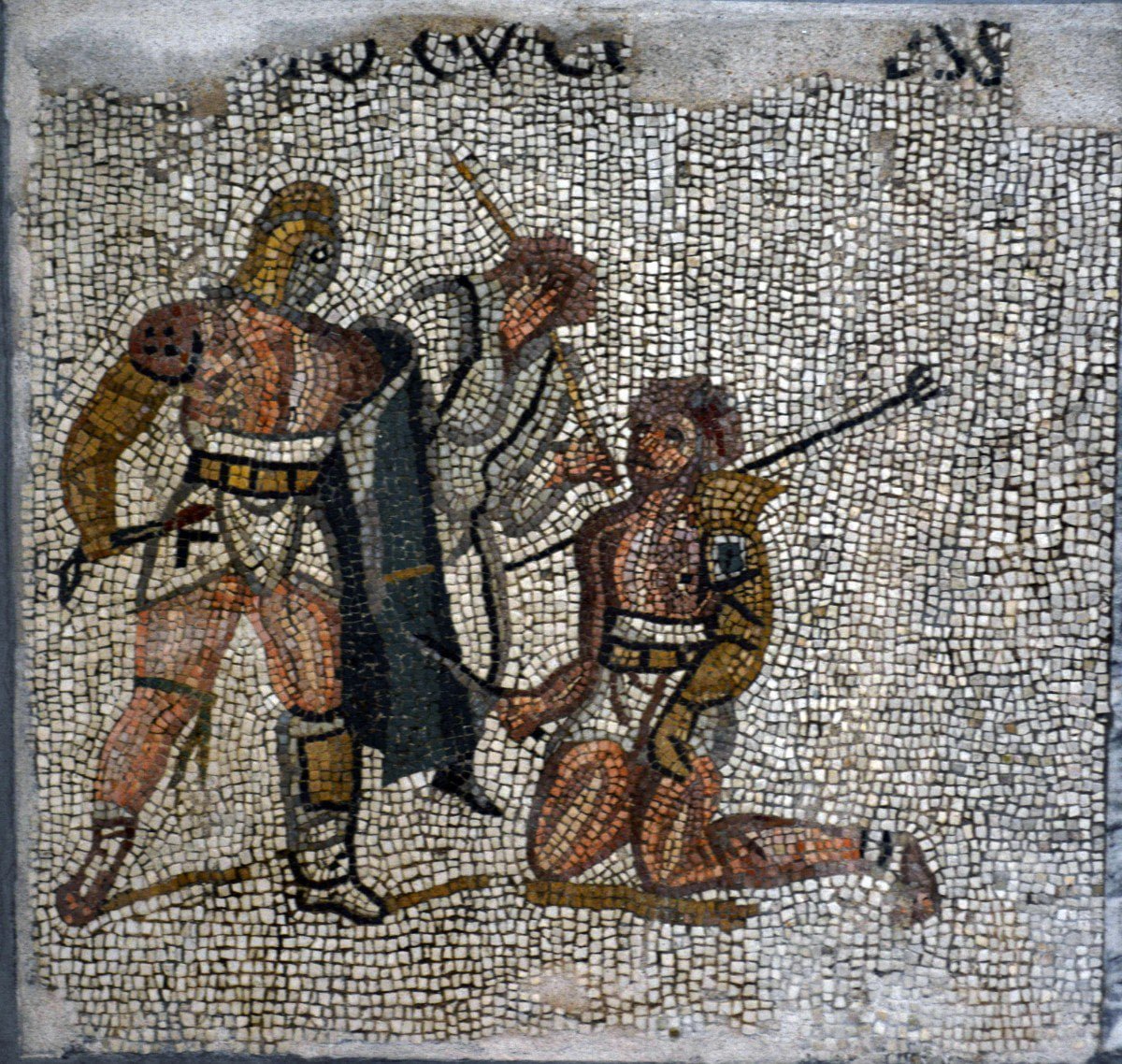

Now this place belongs to the Samians and they replaced it with Marathesion because it was closer. Then comes the small town of Pygela, founded by Agamemnon and inhabited by some of his soldiers, with the temple of Artemis Munkhia. This proper name (it is called hip – buttock in Pyge Hellenic) was given here because some of the soldiers of Agamemnon stayed here due to a disease that caused their buttocks.
Then comes the port called Panormos, where the temple of Artemis of Ephesus is located, and then the city of Ephesus. On the same coast, a little higher than the sea, is Ortygia, a magnificent grove where all kinds of trees, mostly cypresses, grow. In the middle of Ortygia passes the Kenkhrios Stream, where Leto is said to have bathed after labor.
Some of the famous gladiators who lived in Ancient Ephesus
The famous gladiator from Ephesus is Euxenius. (Provocator) won 15 fights. He later taught at the gladiator school of Ephesus. A monument was erected in his name by his students.
The other famous Gladiator of Ephesus is Palumbus. (Murmillo) won 15 fights. A tombstone was specially made for him by his wife, Hymi.
Another famous gladiator of Ephesus is Satornilos. (Secutor) It is known to have won 10 Gladiator fights.
Kalitos from Mylasa (Milas), who participated in the Gladiator fights in Ephesus. (Murmillo) It is told that he fought 14 fights in Ephesus and Milas arenas. Kalinos of Mylasa, who was the master of gladius, fought with his right foot forward, and his helmet became a symbol for other gladiators.
We learn the names and classes of some Ephesian gladiators from monuments, tombstones and inscriptions addressed to them. (Afternoon death Ephesus gladiators /Ephesus Museum Selcuk)
Gladiator of Ephesus Hippolytus (gladiator class – Gallus)
Gladiator of Ephesus Seidonis (gladiator class – Thracian)
Gladiator of Ephesus Kaptialos (gladiator class – Provocator)
Gladiator of Ephesus Kallimorphos (gladiator class – Gallus)
Gladiator of Ephesus Euprepes (gladiator class – Provocator)
Gladiator of Ephesus Asbolas (gladiator class – Secutor)
Gladiator of Ephesus Gegner (gladiator class – Retiarius)
How did the Gladiator fights in Ephesus end?
Spectators would bet on which gladiator would win. During the fight, the spectators tried to motivate their gladiator to win, chanting Herbera (hit) veua Iugula (kill). There was a referee during the fight, and the fight would continue according to the rules determined by the referees.
If one of the gladiators gave up, he would raise his left hand in the air and ask his opponent to take pity on him and not kill him. However, not the rival, but the governor or the most powerful person or the owner of the gladiator at the head of the city of Ephesus usually left the decision to the audience, and they decided in line with their tendencies.
If the spectators wanted forgiveness of the gladiator who lost the fight, they would shake the handkerchiefs they were holding. If the people from Ephesus and the surrounding cities, who watched the gladiators’ matches, did not want to be forgiven, they would shout Iugula (kill) this time.
In this case, the most powerful person of the city of Ephesus, or the owner of the gladiator, would point the thumb of his right hand to the ground, pointing downwards.
The gladiator who won in the arena was rewarded. He was given a wreath made of palm branches and a silver plate with gold coins inside. Thus, the gladiator would become both rich and famous. If, after the struggle, he was given the freedom stick called “Rudis“, he would have been freed from slavery. Wreaths of victories are depicted on the tombstones of many gladiators.
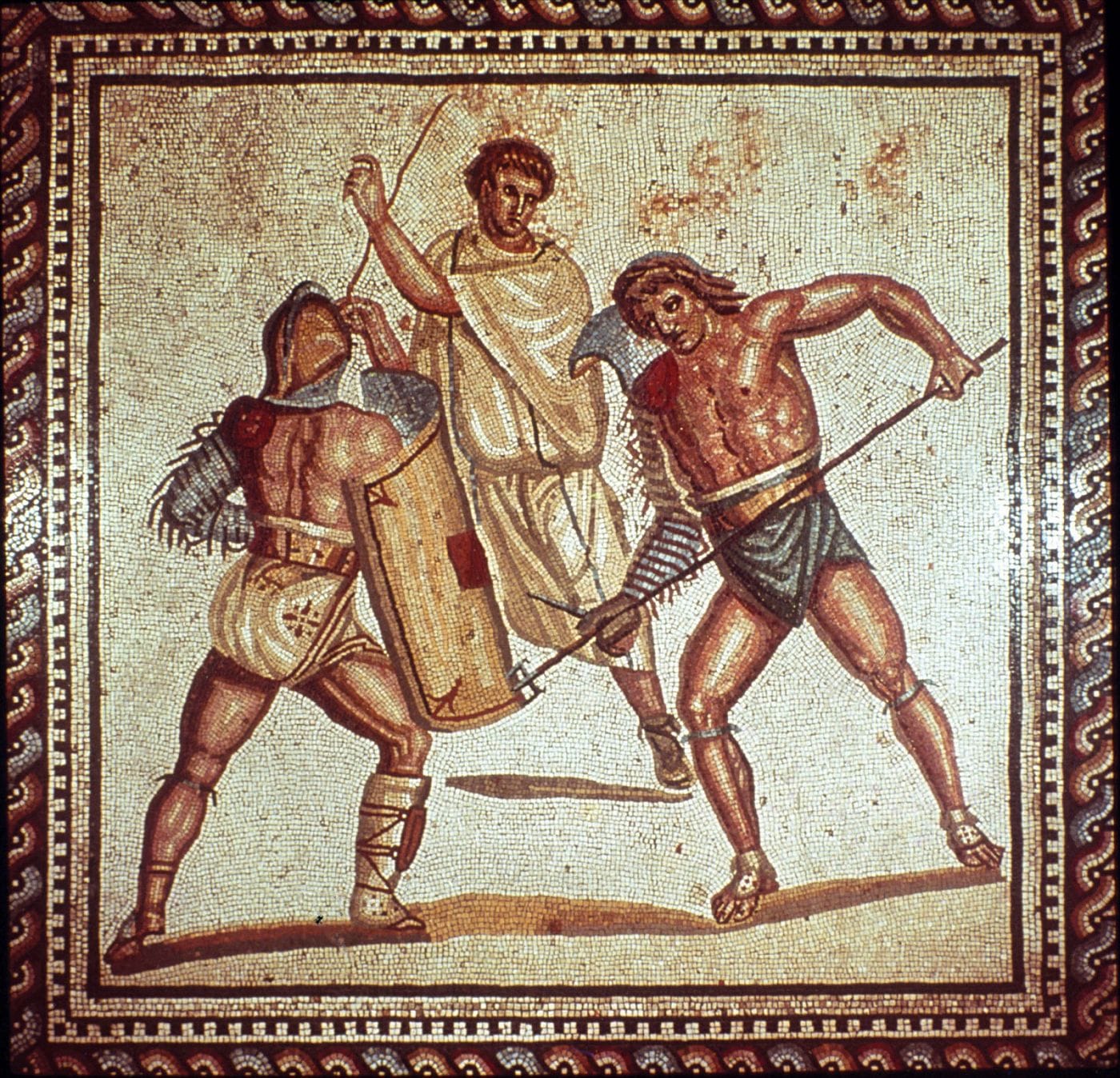
Gladiators who successfully left their fights within five years were usually released by their owners. Such gladiators (veteranus) were assigned to teach swordsmanship to Roman soldiers in Ephesus and subsequent major cities.
Gladiator fights M.S. In the 3rd – 4th centuries, it left its place to the struggles of animals.
Animal hunting and animal struggles (Venationes) were held in theaters that were converted into an arena by separating the orchestra section from the sitting area with a high wall, or in the spendone (half-round section) of the stadion.
In these shows, the animal (wild boar, gazelle, mountain goat, etc.) released into the orchestra was hunted by a hunter, or a person armed with a skewer or spear was fighting a predatory animal (panther, lion, bear, etc.) and trying to kill it.
There were also times when two animals (roosters) were wrestled. These games continued for 3-4 days.
Classes of Gladiator games performed in Ephesus, Anatolia, Rome;
1- Thracian
The most famous, most popular and beloved gladiator among this class is Spatakus. Spartacus was a prisoner of war from the Thracian tribe in southeast Europe. He started a rebellion against the people who had trained him as a gladiator and forced him to fight, who had enslaved him.
He led his slave followers and gathered an army of more than 70,000 rebels during their war with the Romans. He was eventually defeated, but his legend still lives on today.
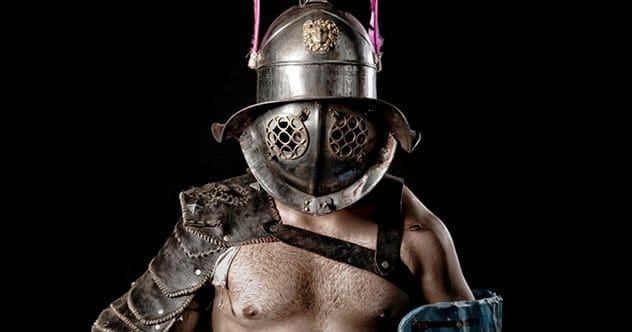
Using a round shield, curved sword, and a large helmet with the griffin symbol on it, the Thracians were probably the most popular and most common of the ancient gladiators. They fought mostly Gauls and Samnites. Emperors and senators had their own favorite types of gladiators, just as we support sports teams.
For example; Caligula was supporting the Thracians, and he killed another gladiator, who defeated the Thracian warrior he had hired, just for that reason.
When Caligula fought in the Colosseum, he had done his martial training as a Thracian, which could lead to decisions such as favoring the Thracians. Another emperor, Domitian, had such a hatred for the Thracians that he once threw one of the audience at the dogs.
The crime of the audience was that he had claimed that a Thracian could win the fight.
2- Samnite
The Samnites are another of the ancient gladiators and share many similarities with Gallus. They, too, were originally prisoners of war, but came from the Samnium region of southern Italy. When the Romans proclaimed their dominance over the Samnites, they forced them to stage ceremonial battles in a sarcastic manner.
Because of their popularity, these ceremonial battles eventually evolved into gladiator encounters, in which the Samnites donned large rectangular shields, swords, and their traditional military garb.
They fought with other soldiers taken captive from the tribes that were in conflict with Rome. Forced to fight in their own unique military style, Rome had the unique opportunity to see rival clans at war.
Finally, they fought rivals dressed as Roman legionnaires to portray Rome’s victory over other tribes (in these encounters, Rome was winning as it should have been, creating an otherwise embarrassing picture).
After Samnium joined Rome as a province, they did not participate in the fighting as a separate category. Instead, they evolved into hoplomanchus or murmillo gladiators with similar weapons and clothing.
3- Gallus / Murmillo
Gallus (Gaul) is one of the oldest gladiators descended from the Gallic tribes of central and western Europe. After being taken as a prisoner of war, they began to fight. Beneath their heavy armor, they looked like the typical gladiators we know, with long swords, shields and helmets, but dressed in traditional Gallic fashion. Less agile than other types of gladiators, Gallus relied on their strength and brute strength when attacking their opponents.
Often they fought with captives from rival tribes. When there was peace between Gaul and Rome and he became part of the Roman Empire, forcing his allies to fight just for fun was not tolerated. So they turned into another type of gladiator named Murmillo.
Afterwards, murmillo again wielding a heavy sword and shield, this time dressed like a Roman soldier and fighting other murmillos, gladiators in rival barracks, and the net-throwing Retiari. Marcus Attilius, who managed to defeat Hilarus, a gladiator from Nero’s own army in his first fight (win/loss record is 12/2, respectively), is among the famous murmillos. Attilius continued this success with a 13-0 win over Lucius Felix.
4- Gladiatrix
The debate about women’s participation in martial arts is actually not new (not new). Thousands of years ago, philosophers and senators such as Cassius Dio and Juvenal discussed the positive aspects of women taking part in the fights at the Colosseum.
Gladiatrix wore very small armor, leaving her chest open, and often did not even wear a helmet to reveal her gender. These battles, using a short sword and possibly a shield, were rare and considered novelties.
In addition to fighting each other, they fought the dwarves to stir up the crowd, causing shock and anger on the crowd. In an extreme example of the aristocratic section who tossed the corset aside and replaced it with simple clothing, we see that many gladiatris come from the higher strata of society, unlike the lower class or slave gladiators.
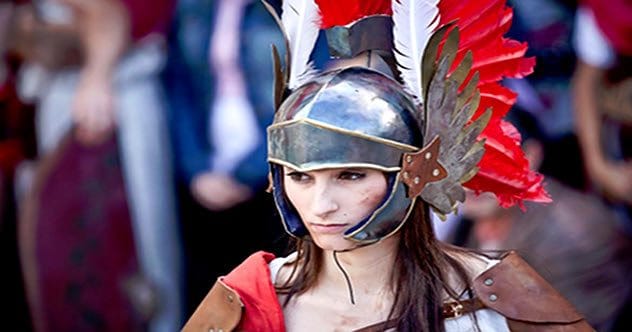
Their existence caused such a great scandal that they eventually became A.D. They were banned in 200.
In 22 BC, the law of Augustus “preventing the professional gladiatorship of women” was not accepted by the senate. However, it was banned by Septemus Severus in AD 200. Thus, the Gladiatrices, who were made to fight for 200 years, became history.
5- Provocateur
As we now know, in most encounters, gladiators of different kinds faced each other. On the other hand, a provocateur could only fight another provocateur. This was because instead of deciding the match for them, they would challenge each other to fight in the arena. There was pure competition in this fight.
They would fight to settle disputes between rival gladiator schools or to raise their own status by defeating a highly respected opponent. To reflect equality, each wore legionary (Roman soldier) armor with large rectangular shields, breastplates, and helmets. Wearing heavy armor meant that they would tire quickly, but it was also difficult for them to be damaged during combat.
6- Equite
Although they share some similarities, equites gladiators should not be confused with the Roman cavalry of the same name. The Roman cavalry consisted mostly of inferior aristocrats who held secure positions in the senate and could even become emperors. Equites, who were gladiators, were highly acclaimed showmen.
Since the odds of death alone were not enough, the competition at the Colosseum began with the equites, often due to their agility and display of speed to enliven the crowd. Starting on horseback, they would attack each other with their spears and then dismount and fight with a small sword and shield. They wore light armor to better use their quickness and athletic build.
7- Secutor

The Secutor wore heavy armor: he had a large shield, a sword, and a round helmet that covered his entire face except for two small eyeballs. These gladiators were developed as a match of fighting styles to rival the increasingly popular retiarius. A typical encounter between secutor and retiarius would begin with the retiarius standing at a safe and distant distance – in some cases on a high platform above the water – with piled boulders ready to be thrown.
The Secutor (which means chaser in Latin) would march towards Retiarius, trying not to get caught in its net or to avoid the rocks hitting him. He also had to avoid the trident, which the retiarius used to keep the secutor too far away from him. The Secutor had the advantage of being heavily armored, but would also tire easily from the weight of his armor.
This resulted in a breathtaking encounter. Emperor Commodus fought as a secutor in the games and set all the conditions perfectly so that there was no obstacle to his winning the match.
Another famous secutor was the Syrian warrior Flamma, who dressed appropriately for the Gaul region.
He fought 34 times, with a win/withdrawal/loss record of 21-9-4. Interestingly, despite being offered freedom four times, the opportunity was blown out each time.
8- Retiarius
Which is better, speed or power? Is it better to die with a thousand cuts or a single move? In Roman times, the answer was definitely that more power and armor was better. This is why the retiarius was formerly viewed and despised as a lowly gladiator; He had very little armor and had to fight using agility, speed and cunning.
But to make up for it, they had nets that ensnared opponents, tridents to stab and move, and finally, a small dagger, which in some cases was four-pronged.
Retiarius trained in a different barracks than gladiators wielding “sword and shield” and often lived in worse conditions. According to others, they were seen as feminine and ridiculed. The satirist and poet Juvenal told the story of Gracchus, a second-rate aristocrat who, by becoming a gladiator, not only humiliated him, but fought as a retiarius, causing even greater shame in society.
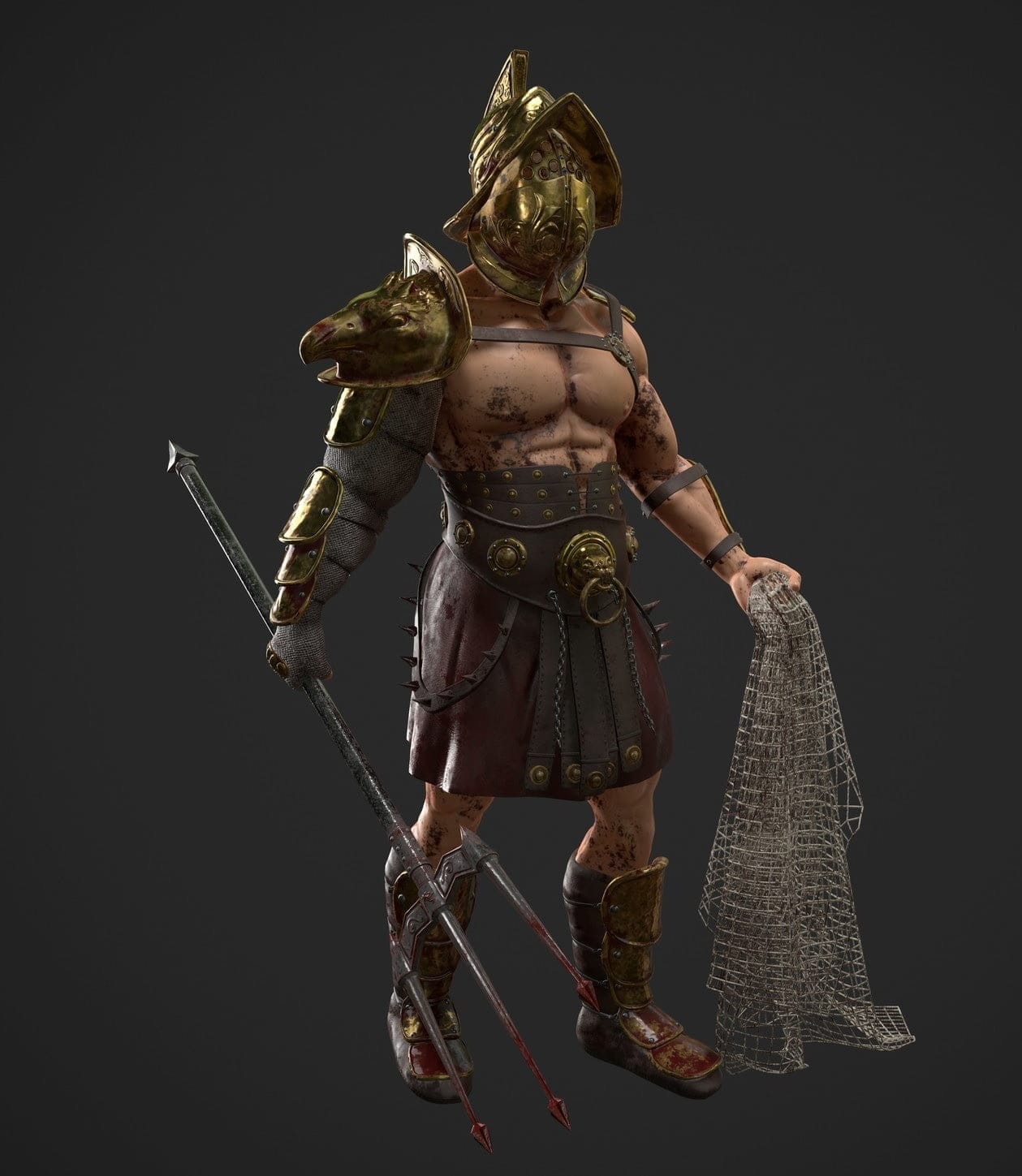
However, their importance grew to some extent over the centuries, and they succeeded in maintaining arena continuity, complementing the different styles of armored secutors, murmillos, and scissores (a type of gladiator wielding a sword with two blades).
9- Noxii
The Noxies were the lowest strata of the lower class people in Roman society. These people, the lowest class of the civilian population, were viewed as so disgraceful in Roman society that they were not even classified as human beings.
Such people included Christians, Jews, deserters, murderers, and traitors (in no particular order). They were not chosen for gladiator school, and their sole purpose in being in the arena was to die in the bloodiest way possible as punishment for their crimes.
There were several ways in which Noxii could die. One was the “bestiari” encounters with animals, where they would be torn to pieces by the animals.
In the other, the warriors were blindfolded and instructions were given by the crowd, as if playing a sadistic blind game. Another method was to be thrown among real gladiators as if they were prey. The noxies, who were mostly able to wear a cloth covering the genitals or naked, had no armor and used small swords or sticks called “gladius” as weapons. The Romans enjoyed killing the noxies.
While these killings served as a reminder to the civilian population of the superiority of law and order, they also served to once again show their place in the social hierarchy.
10- Bestiarii
Unlike other gladiators, the bestiarii faced animals, not humans, in the arena. Roman emperors and senators used exotic and powerful animals imported from Africa or Asia (e.g., lion, tiger, elephant, bear) to flaunt their wealth, and held grand performances in the Colosseum and theaters for the public. Some animals, such as the elephant, were captured to surprise and entertain the crowd with these creatures they had never seen before.
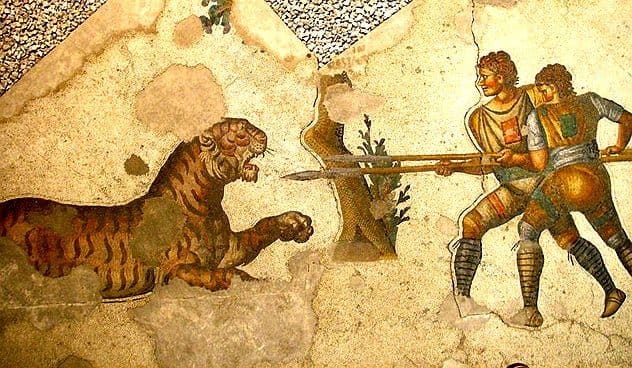
Others were there to hunt and hunt. There were two main types of composers: “damnatio ad bestias” (cursed with the creature) and “venatio” (hunter). The Damnatios were those sentenced to death and thrown into the arena for a humiliating and frightening way into the afterlife. Because they were not considered gladiators – they were the lowest class of the people in ancient Rome – their death was for the amusement of the crowd, and a single creature could kill thousands at a time.
As part of his performance, Venatio would train and hunt animals for the crowd.
Few known venatios have been recorded by historians and chroniclers because, compared to other gladiators, this group was underrated. Carpophorus, who is said to have killed more than 20 animals with his bare hands in the Circus Maximus, is the most famous example.
They also trained these animals to kill, hunt, and rape their victims, as befits the time. A few emperors demonstrated their skill at killing animals as composers, but this damaged their popularity rather than impressing the crowd.
While Nero fought the beasts in the Arena, Commodus fought the wounded and immobile beasts “heroically” from a safe, high platform, to the delight of the senate rather than to the revulsion.
Equites, Provocatores, and Essedari were classes that could only fight an opponent of their own class. This was due to the fact that some equipment was superior to other equipment and gladiators were not trained with these weapons.
The Murmillo would fight with those of the Thracian or Hoplomachus class, while Retiarius would fight against the Secutor or, rarely, the Scissor. In addition, there were female gladiators, albeit very few in number. We see two Gladiatrices fighting on a memorial stone in Bodrum; Amazon and Achillea.
Female slaves would either fight alongside their male counterparts or face off against dwarf gladiators, considered Domitian’s personal pastimes.
Gladiator games were completely abolished by Theodosius in 325 AD in Istanbul and by Honorius in Rome in 404 AD.
The heroes of the people of Ephesus are gladiators
Gladiators were the killing machines of their time, but they were loved by the people of Ephesus. Although they were captives, they were the most prestigious people in society after the soldiers. In the arena, which was crowded with the Ephesians, when the thumbs turned down for the sign of death, the person standing and stabbing the deadly weapon in his hand into the ground suddenly became everyone’s lover. Legends about them were circulating.
Crescens of Rome, one of the most famous, was a casanova who ensnared women, Celadius was the lover of young girls, Palumbus of Ephesus was a adoring husband, Euxenius of Ephesus was a retired gladiator who gained his freedom and was loved by his students.
The gladiator standing in Ephesus could have been freed
Gladiators would sometimes find a slave like themselves, and sometimes a fierce lion or bear. The result would usually be death. At the end of the fight, the gladiator who stood up three times passed into the master class, and the one who stood up five times would gain the right to freedom.
But few gladiators chose freedom and left the schools. Those who remained in the schools trained the most popular officers of the army.
First training, then fighting at the Gladiator school in Ephesus
A master gladiator, who had risen to the rank of teacher, would teach his two students to fight, the teacher would explain how to make a move with a stick and give detailed information about how his student countered that move. Afterwards, the combat techniques of gladiators would pass from theory training to practical training.
Gladiators completed their training, which lasted for about four years, with wooden weapons, and met with real weapons shortly before entering the arena.
The training of gladiators was carried out in stages. A separate training was given for each weapon and each stance. Gladiators, who were constantly fed protein foods, turned into muscle mass and then death machines.
Ephesian gladiators sentenced to death
The first gladiators were criminals sentenced to death for any crime. They were told that they were guilty with a rope around their necks. The prisoner who survived the first fight in the arena was taken to the gladiator school and trained. There were also opponents of gladiator fights. Those who did not want to protest the fights in the theater in various ways.
They even showed their protest by destroying a relief depicting a mass fight.
The deadliest techniques in gladiator fights in Ephesus
The bones unearthed from the gladiator cemetery in the Ancient City of Ephesus were examined by bone scientists, and it was determined with which weapon they were killed. The location of the bone and the shape of the blow were also shown with the simulations.
The gladiator, who fell to the ground after the blow he received from the kneecap with a four-pointed weapon, could not respond to the lethal blows of his opponent. The people in the stands surrounding the arena would bow their thumbs down.
This act, which meant that the gladiator who fell to the ground was not forgiven, would end in death. If the fingers were up, the defeated gladiator would be forgiven and treated.
Weapons in gladiator fights
Inspired by the reliefs found in Ephesus, realistic weapons show how deadly the fights were. There is a weapon for every purpose. If the gladio in the hands of the gladiator was not strong enough to pierce his opponent’s armor, he would try to injure his opponent under the armor by using the curved weapon.
Feeding of gladiators fighting in Ephesus and Rome
As ancient historians such as Pliny noted, the Gladiators (Latin; Hordeum – Ordeum = Barley), nicknamed “The Barley Eaters” or “Hordearii”
Pathologist from the Medical University of Vienna, Prof. Karl Grossschmidt and Prof. In a 5-year study led by Fabian Kanz, it was revealed that Roman gladiators almost did not consume meat, contrary to popular belief, and were fed with vegetables and dried fruits, as well as cereals and legumes such as wheat, barley and oats.
Since gladiators do not eat meat, it is thought that they met their energy needs with a mixture of vinegar and plant ashes, considered “energy drinks” of the period.
Traces found on skeletons in Gladiator tombs in Ephesus
The 120 gladiator tombs unearthed by the Austrian Archeology Institute during the excavations of the “Stoa of Damianus”, that is, the Sacred Way, behind the Ephesus Stadium, between 1991 and 1995, are important in two respects: First, it is the first known mass gladiator tomb in the world that has been approved by science.
The second is that the legendary warriors of the Roman world gave important clues about their lifestyle, diet, weapons used in gladiatorial games, and death styles.
Almost all of the skeletons thought to belong to one of the ‘free-trainer’ gladiators were found in the Ephesus Gladiator tombs. The skull of this middle-aged gladiator has traces of healed wounds, none of which were fatal. According to Professor Kanz, he died at the age of 50, most likely of natural causes.
In the study, 67 individuals aged between 20 and 30 were determined. Most bear scars from healed wounds, meaning individuals have received good medical care. One even has traces of surgical amputation (arm or leg amputation). The absence of multiple scars on the bones indicates that they participated in well-regulated duels rather than crowd fights.
However, there are also traces of fatal wounds. Of the 67 individuals, 44 had healed acute scars, which must have led to sudden death. Only 10 fatal (perimortal) injuries were detected in the skulls. This is astonishing, considering that most gladiators wear helmets.
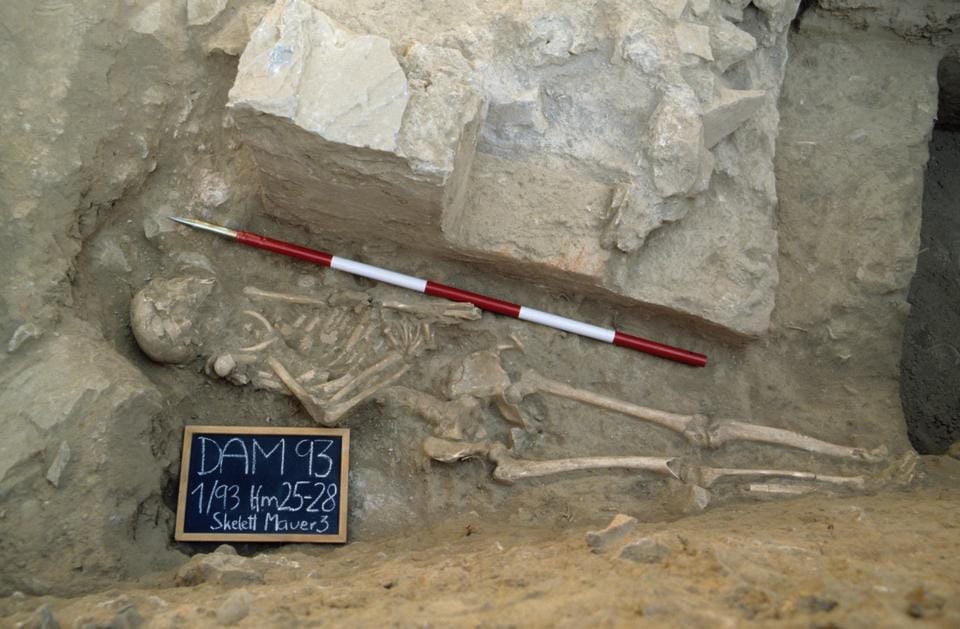
The only possible explanation is that the death hit was made with the hammer, which was associated with the God of Death, Dis Pater. This high rate of injury indicates that gladiators who died in the arena or immediately after competitions were buried in the cemetery.
The explanations of the researchers for the trident blows found on the skulls are as follows: “These certainly do not look like the marks of accidental blows that can be encountered in everyday life. However, not all head injuries are of this type. Some skulls contain rectangular holes, possibly from heavy hammer blows;
This supports the “last shot” view accepted by archaeologists and historians. Apart from the weapons found during the excavations, the wound itself has been evidence for a variety of weapons considered legendary.
The gladiator, who could not show enough skill or courage, could scream “iugula” according to the rules, that is He could have stated that he wanted to die “like a man/valiant”. This request was fulfilled by an attendant as a “final strike” with a hammer with a four-point mark. This officer dressed as Charun during the Etruscan period and as Hermes during the Roman period.
Charun/Karun is the demon in charge of spirits living in the Underworld and holding a hammer, not to be confused with the underworld lord Aita. Charun also guides spirits after death, just as Hermes guided spirits….
History of gladiators and gladiator fights
Although they were captives, the most prestigious people in the society after the soldiers were Gladiators. Gladiator fights, which means “Swordman” in Latin, are of Etruscan origin, and were built by the Etruscans in the Circus Maximus in Rome, where all kinds of races, including gladiator games, were held.
It is said that he saw the prototype of the professional gladiator games of the Romans from the Samnites tribe, who are said to be from the Sabines, whom they fought in the 4th-3rd century BC.
Equipment of the defeated Samnites was also used in the arena; an elaborate helmet, a wide leather belt reinforced with metal and bands, a large rectangular shield and a sword, Gladius (Gulan dividere, divides the throat-Isidore Seville XVIII.6), meaning “throat divides”.
The other class of gladiators was also named after the defeated tribes; Like Welsh (Gauls) and Thraeces (Thracians).

The Samnites tribe lived in the region of Campania, where the Etruscans settled. Another tribe that settled in this region was the Cimmerians (Cimmerium city in Campania. Prof. Cengiz Garasarli. Trojans and Etruscans-sy.94).
There is a Gladiator Museum in Capua, Italy. The Etruscans founded the city of Capua in the Campania region around 800 BC. After the attacks of the Samnites in the 5th century BC, it passed into the hands of the Romans. (Capua was founded by the Etruscans around 800 BC)
Prof. Although Meijer gives the example of “Nicolaus of Damascus (1st century BC): “The Romans copied the games from the Etruscans” in his book, Meijer opposes the Etruscan origin and argues that it originated from the Hellenic colonies that came to Italy in the 8th century BC.
It connects that there are no pictures or statues of Gladiators in Etruscans.
However, there are no gladiator games in the Hellenes, which was passed on to them from the Romans.
When the Etruscans migrated to Italy around 1200 BC after the Trojan War, they organized these games, which had not yet become wild, as a funeral ceremony in memory of their ancestors.
Although the Etruscans had a “blood sacrifice offering” in the tombs of nobles to appease the spirits of the dead, there is no obligation to sacrifice blood in the gladiator games called Munera.
The real meaning of Munera is to take responsibility, to take responsibility. The responsible person/family would organize and specifically finance such games. During the republican period, the prestige of the families who organized the Muneras (gladiator fights) increased, adding fame and wealth to the family name.
The sons of Junius Brutus were introduced to Rome for the first time in 264 BC. They organized a gladiator game consisting of 3 couples to honor their father. Officially, gladiator fights were held between the 1st century BC and the 5th century AD.
Although it started as a funeral ceremony, it gradually got rid of its religious character and turned into an indispensable public entertainment for political or national demonstrations. Even schools (ludus) were established to train gladiators for these “entertainments”.
There were 4 important schools/ludus in Roman times:
Ludus Magnus: Founded by Domitian (81-96)
Ludus Gallicus: Founded by Domitian (81-96)
Ludus Dacius: School started by Domitian and finished during Trajan’s reign.
Ludus Matutinus: It is a school that breeds only Venatores and Bestiarii and makes animals fight.
Gladiator fights, which were held twice a year, lasted 10-12 days. After the Spartacus revolts (73 BC), although the Senate opposed these fights to be held in Rome, Jules Caesar organized 320 double gladiator fights in silver armor in 65 BC in honor of his father, who died 20 years ago.
Eight years later (46 BC), when Caesar’s daughter Julia died in childbirth, “gladiator fights” were held again. This time, a game is held with animals, and for the first time a giraffe is walked through the streets of Rome. When they are not paid their allotted pay in this fight, protests begin and many, including Caesar’s own soldiers, are slaughtered.
It is known that Trajanus, who ruled between AD 98-117, had 10 thousand gladiators fight in a single game week. (Pliny, Plutarch) In these brutal “fights”, prisoners of war, slaves and prisoners receive a separate training for each weapon, each posture. The gladiator who survives three times goes to the master class, and the one who survives five times gains his freedom.
The rest can be trainers.
There are those who are against gladiator fights and have protested in various ways.
Names and classes of tools used in Gladiator Terminology:
Tiro – Beginner, novice.
Magistri – A gladiator who had previously trained and fought in the arena.
Lanista – The manager who oversees the training process.
Doctores – Different style combat experts.
Rudis – A wooden sword used by gladiators in training. Also, the wand of release given to the Gladiator who won his freedom.
Eques: Small round shield, spear or sword. A metal or leather armor called “manica” on the sword arm. They always fought each other, first with the spear on the horse, then with the sword.
Provocator: Large rectangular shield, helmet, short sword.
Murmillo: Gladiator class named after the Gallic war. Large rectangular shield, shielded helmet, short sword. Leather or metal protection on the weapon arm, thick leather belt with metal ornaments.
Secutor: Large rectangular shield called “Scutum”, helmet, short sword. Metal or leather armor called “ocrea” on the left leg, metal or leather armor called “manica” on the right arm.
Thraex: Thracian style weapon, square or round small shield, a curved blade called “sica”, helmet.
Scissor: Helmet, sword, arm cuff with a sharp moon-shaped blade (hence the gladiator “scissors”)
Retiarius: Spear (trident), net (retiarius means White-Man/Warrior) and dagger (pugio) do not use helmets.
Hoplomachus: Hellenic-armed (Hoplite) (Hoplomachus-armed warrior). Protective “manica” of bronze or iron, fastened with leather straps on the right arm. Heavy armor on his legs and a bronze helmet. Sword or spear.
Essedarius: Gladiators brought from Britain, possibly by Julius Caesar. They are seen as arena warriors after the 1st century AD. They fight from the car.
Shield-wielding factions differed in sword size and usage patterns. There were definite, clear and unchangeable rules for the creation of couples.
“The Romans, who are lords of the world, honor a gladiator for a trivial deed more than the emperor who is accepted into the gods, or me who is present here”.
Caligula,





